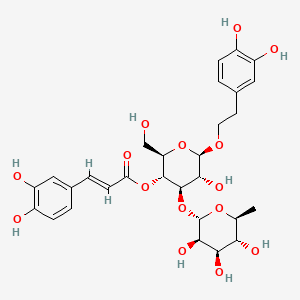



1. Glucopyranoside, 2-(3,4-dihydroxyphenyl)ethyl 3-o-(6-deoxy-alpha-l-mannopyranosyl)-, 4-(3-(3,4-dihydroxyphenyl)-2-propenoate), (e)-beta-d-
2. Kusaginin
3. Tjc 160
4. Tjc-160
5. Verbascoside
1. Verbascoside
2. Kusaginin
3. 61276-17-3
4. Tjc 160
5. Acetoside
6. Verbacoside
7. Nsc 603831
8. 3tgx09bd5b
9. Mfcd00221751
10. [(2r,3r,4r,5r,6r)-6-[2-(3,4-dihydroxyphenyl)ethoxy]-5-hydroxy-2-(hydroxymethyl)-4-[(2s,3r,4r,5r,6s)-3,4,5-trihydroxy-6-methyl-tetrahydropyran-2-yl]oxy-tetrahydropyran-3-yl] (e)-3-(3,4-dihydroxyphenyl)prop-2-enoate
11. 22323-52-0
12. Tjc-160
13. Unii-3tgx09bd5b
14. Nsc-603831
15. .beta.-d-glucopyranoside, 2-(3,4-dihydroxyphenyl)ethyl 3-o-(6-deoxy-.alpha.-l-mannopyranosyl)-, 4-((2e)-3-(3,4-dihydroxyphenyl)-2-propenoate)
16. .beta.-d-glucopyranoside, 2-(3,4-dihydroxyphenyl)ethyl 3-o-(6-deoxy-.alpha.-l-mannopyranosyl)-, 4-[(2e)-3-(3,4-dihydroxyphenyl)-2-propenoate]
17. Russetinol
18. Stereospermin
19. Acteoside; Verbascoside
20. Verbascoside [inci]
21. Glucopyranoside, 2-(3,4-dihydroxyphenyl)ethyl 3-o-(6-deoxy-alpha-l-mannopyranosyl)-, 4-(3-(3,4-dihydroxyphenyl)-2-propenoate), (e)-beta-d-
22. Mls002473233
23. Schembl657970
24. Verbascoside [usp-rs]
25. Chebi:9953
26. Chembl231853
27. Chembl444478
28. Tjc160
29. Cid_5281800
30. Verbascoside, >=99% (hplc)
31. Chebi:132853
32. Cid_24978601
33. Dtxsid701021953
34. Hms2205k11
35. Hy-n0021
36. Zinc8234351
37. Bdbm50241867
38. S5458
39. Akos015897165
40. Ccg-270269
41. Db12996
42. Ncgc00378687-03
43. As-75167
44. Smr001397320
45. N1341
46. 276a173
47. B864379
48. Q411426
49. Q-100706
50. Verbascoside, Primary Pharmaceutical Reference Standard
51. Verbascoside, United States Pharmacopeia (usp) Reference Standard
52. ((2r,3r,4r,5r,6r)-6-(3,4-dihydroxyphenethoxy)-5-hydroxy-2-(hydroxymethyl)-4-((2s,3r,4r,5r,6s)-3,4,5-trihydroxy-6-methyltetrahydro-2h-pyran-2-yloxy)tetrahydro-2h-pyran-3-yl) 3-(3,4-dihydroxyphenyl)acrylate
53. ((2r,3r,4r,5r,6r)-6-(3,4-dihydroxyphenethoxy)-5-hydroxy-2-(hydroxymethyl)-4-((2s,3r,4r,5r,6s)-3,4,5-trihydroxy-6-methyltetrahydro-2h-pyran-2-yloxy)tetrahydro-2h-pyran-3-yl)3-(3,4-dihydroxyphenyl)acrylate
54. (2r,3r,4r,5r,6r)-6-(3,4-dihydroxyphenethoxy)-5-hydroxy-2-(hydroxymethyl)-4-(((2s,3r,4r,5r,6s)-3,4,5-trihydroxy-6-methyltetrahydro-2h-pyran-2-yl)oxy)tetrahydro-2h-pyran-3-yl (e)-3-(3,4-dihydroxyphenyl)acrylate
55. (2r,3r,4r,5r,6r)-6-[2-(3,4-dihydroxyphenyl)ethoxy]-5-hydroxy-2-(hydroxymethyl)-4-{[(2s,3r,4r,5r,6s)-3,4,5-trihydroxy-6-methyloxan-2-yl]oxy}oxan-3-yl (2e)-3-(3,4-dihydroxyphenyl)prop-2-enoate
56. (3,4-dihydroxyphenyl)ethyl O-.alpha.-rhamnopyranosyl(1->3)-4-o-caffeoyl-.beta.-d Glucopyranoside
57. .beta.-d-glucopyranoside, 2-(3,4-dihydroxyphenyl)ethyl3-o-(6-deoxy-.alpha.-l-mannopyranosyl)-, 4-[(2e)-3-(3,4-dihydroxyphenyl)-2-propenoate]
58. 2-(3,4-dihydroxyphenyl)ethyl 3-o-(6-deoxy-alpha-l-mannopyranosyl)-4-o-[(2e)-3-(3,4-dihydroxyphenyl)prop-2-enoyl]-beta-d-glucopyranoside
59. 2-(3,4-dihydroxyphenyl)ethyl 3-o-(alpha-l-rhamnopyranosyl)-4-o-[(2e)-3-(3,4-dihydroxyphenyl)prop-2-enoyl]-beta-d-glucopyranoside
60. 3,4-dihydroxyphenethyl 3-o-alpha-l-rhamnopyranosyl-4-o-[3-(3,4-dihydroxyphenyl)acryloyl]-beta-d-glucopyranoside
61. Beta-d-glucopyranoside, 2-(3,4-dihydroxyphenyl)ethyl 3-o-(6-deoxy-alpha-l-mannopyranosyl)-, 4-[(2e)-3-(3,4-dihydroxyphenyl)-2-propenoate]
| Molecular Weight | 624.6 g/mol |
|---|---|
| Molecular Formula | C29H36O15 |
| XLogP3 | -0.5 |
| Hydrogen Bond Donor Count | 9 |
| Hydrogen Bond Acceptor Count | 15 |
| Rotatable Bond Count | 11 |
| Exact Mass | 624.20542044 g/mol |
| Monoisotopic Mass | 624.20542044 g/mol |
| Topological Polar Surface Area | 245 Ų |
| Heavy Atom Count | 44 |
| Formal Charge | 0 |
| Complexity | 936 |
| Isotope Atom Count | 0 |
| Defined Atom Stereocenter Count | 10 |
| Undefined Atom Stereocenter Count | 0 |
| Defined Bond Stereocenter Count | 1 |
| Undefined Bond Stereocenter Count | 0 |
| Covalently Bonded Unit Count | 1 |
Immunosuppressive Agents
Agents that suppress immune function by one of several mechanisms of action. Classical cytotoxic immunosuppressants act by inhibiting DNA synthesis. Others may act through activation of T-CELLS or by inhibiting the activation of HELPER CELLS. While immunosuppression has been brought about in the past primarily to prevent rejection of transplanted organs, new applications involving mediation of the effects of INTERLEUKINS and other CYTOKINES are emerging. (See all compounds classified as Immunosuppressive Agents.)
Antineoplastic Agents, Phytogenic
Agents obtained from higher plants that have demonstrable cytostatic or antineoplastic activity. (See all compounds classified as Antineoplastic Agents, Phytogenic.)
Chelating Agents
Chemicals that bind to and remove ions from solutions. Many chelating agents function through the formation of COORDINATION COMPLEXES with METALS. (See all compounds classified as Chelating Agents.)
Anti-Infective Agents
Substances that prevent infectious agents or organisms from spreading or kill infectious agents in order to prevent the spread of infection. (See all compounds classified as Anti-Infective Agents.)
Antioxidants
Naturally occurring or synthetic substances that inhibit or retard oxidation reactions. They counteract the damaging effects of oxidation in animal tissues. (See all compounds classified as Antioxidants.)